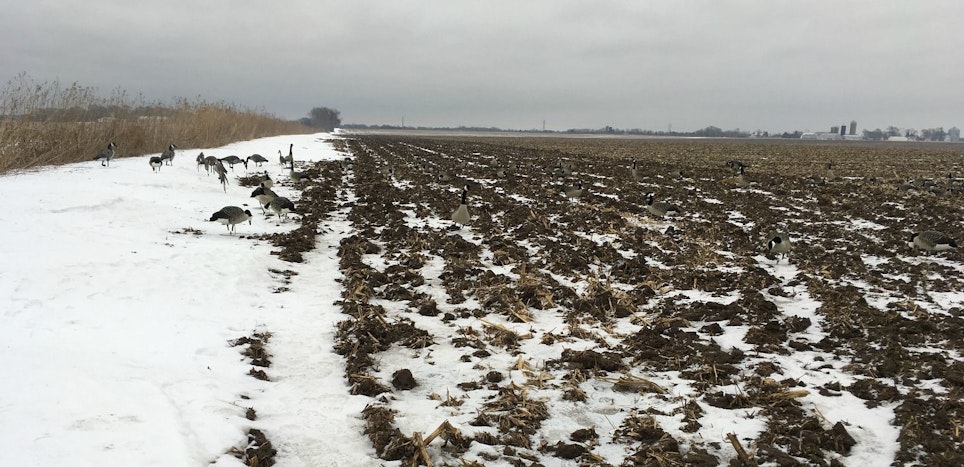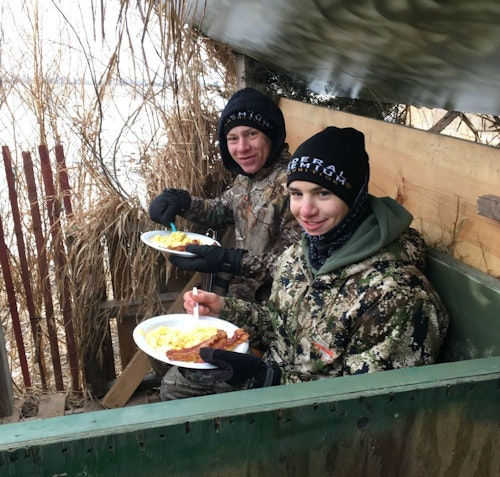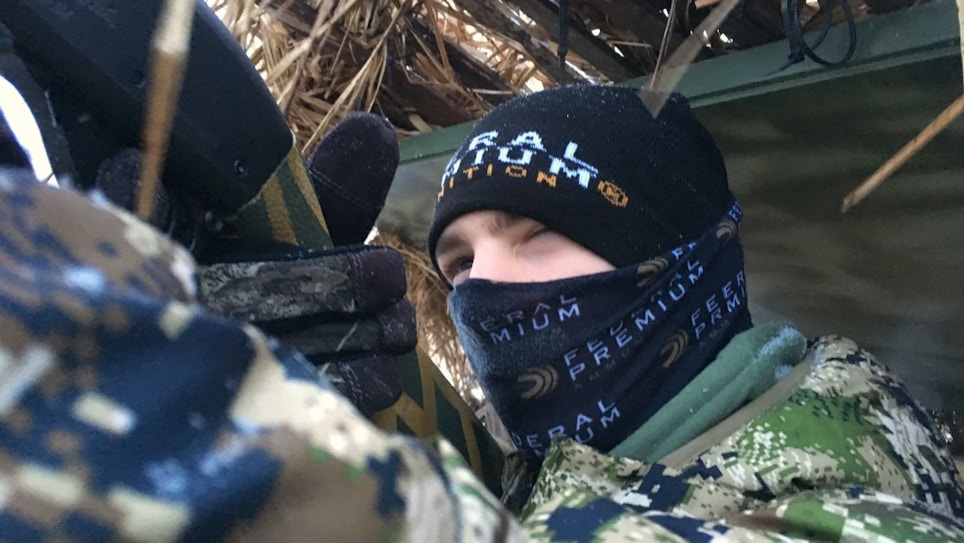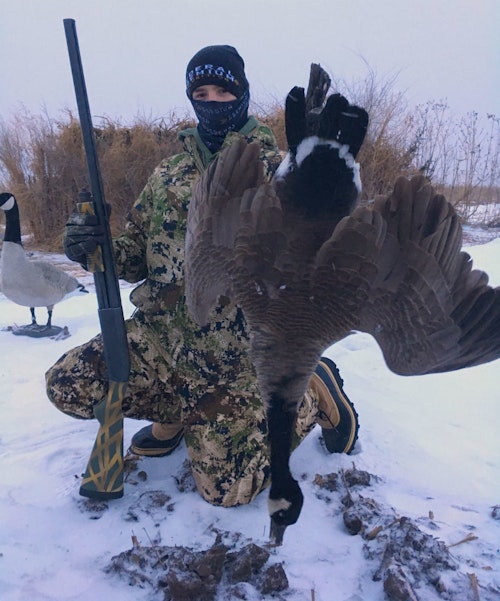Each fall I spend many more days in the deer stand than duck blind, but my 16-year-old son has fallen in love with waterfowl hunting, meaning my dad duties have largely shifted from bucks to birds. And I must say it was a welcomed change. Not only did I learn a lot from him, but instead of repeating my role as “decoy Sherpa” during 2018, I plan to purchase all the required licenses and stamps in 2019 and enjoy some trigger time as well.
We already have a DIY snow goose roadtrip planned to southeast South Dakota this spring. And while I’m just getting started figuring out what gear is necessary for that adventure, our recent New Year’s Eve goose hunt in our home state of Minnesota taught me a lot about ammunition and more.
Too Mild = Tough Hunting
“Dave, I’m not gonna lie to ya,” said my buddy Todd Gifford. “I wish I had better goose news. Because of the relatively mild conditions for late-December, and no snow, the geese can feed anywhere. I have a couple permanent blinds set up adjacent to hail-damaged standing corn, but the geese are so scattered now that it’s not going to be a slam dunk. But we’ll give it a shot.”
As I implied earlier, I didn’t hunt waterfowl in 2018; I simply supported my son Elliott on his many outings. So, rather than buy a license and the required stamps for 1 day of goose hunting, I chose instead to watch and learn, and shoot photos. Todd’s goose blind is large enough for a few hunters, so joining Elliott was his good waterfowl-hunting buddy, Ty. Todd was also hunting, so we had three guns and one cheerleader (me.)
“As you can see, because of the lack of snow on this plowed field, it’s hard to even see the full-body goose decoys,” Todd explained to us as well approached his blind. He had driven onto the frozen field an hour before our 8 a.m. arrival to set six dozen Avian-X Canada goose decoys. “I placed a handful of decoys on the snow along the edge of this weed line, hoping the birds will spot them from the distance,” he continued. “But it sure would have been nice to have 2-6 inches of snow covering all the fields.”
Elliott and Ty had spent enough time pursuing ducks and geese during fall 2018 to understand that you have to make the best of the conditions, so they loaded their shotguns and settled in to wait.
“I’ve been scouting these birds regularly,” Todd began, “and they’ve been leaving the river at around 10 a.m. to find food. The spend the night north of us a couple miles, then generally fly south, over our blind, to various feed fields. But like I said before, the birds have a lot of choices because it’s been mild, so getting them to stop and check out our spread will be a challenge.”

Birds in the Air
We’d waited for an hour when Ty heard the first honks coming from the north. About two dozen Canada geese were coming in line with our blind, but they were too high to shoot. Even though Todd tried desperately to call the birds into shooting range, they weren’t interested. And sadly, this same pattern repeated itself over and over again for the next hour.
The good news is we saw thousands of geese. The bad news, none of the three hunters flipped off the safety of their shotgun.
“Well guys, I’m thinking that will be about all the action for the morning,” Todd confessed. “There’s a chance we could encounter a few stragglers throughout the middle of the day, but as you saw, the big groups all headed farther south to other fields. There were a lot of birds, so hopefully we’ll get our chance when they return north to the river before sunset. All with can do is wait.”
I could tell that the kids were a bit disappointed, but hunting is hunting. As I’ve told Elliott a few times in the boat while fishing and in the blind while hunting, “You appreciate the stellar days because you experience tough ones.”
Even though the morning flight resulted in no close calls, I could tell that Elliott and Ty were enjoying picking Todd’s brain about ducks and geese. In addition to hunting around his home in southeast Minnesota, Todd also spends a lot of time in western Minnesota, near the South Dakota border. This is where Elliott dedicated many days during 2018, so he tried to learn as much as possible about this area from Todd while waiting for the geese to reappear in the afternoon.

Here They Come!
As the hours clicked by, we ate lunch and talked hunting. And as I thought about the close of 2018, I couldn’t think of a better way to spend New Year’s Eve. Instead of waiting for a giant ball to drop in Times Square, we were waiting for a giant Canada goose to drop in our decoys.
Again, Ty heard the first honkers. Instead of trying to see the geese coming from behind the blind as was the case during the morning, however, the geese were easy to spot directly in front of us. But again, they were high.
Todd hammered his goose call, but the birds simply wouldn’t descend. They were on a mission to get back to the river.
Thankfully, this was only the first group, and soon we could see multiple groups of honkers making their way from south to north. At one point, a dozen geese came overhead and Todd almost called the shot, but the birds were just out of range.
“Don’t worry guys,” Todd said. “At some point we’ll get our chance. Hang in there.”
And he was right. A group of about 15 geese were flying along a weed line that separated two fields, and our blind was positioned perfectly to intercept them. “I’m not going to call,” Todd advised. “They’re heading our way, and right now they’re low enough to shoot. Let’s just let them come.”
Soon, I watched Todd, Ty and Elliott stand up with guns raised. Even though to my rookie eyes the Canada geese looked too high for a shot attempt, Todd said, “Take ‘em!”
With the geese positioned directly overhead, the shot angle was difficult to say the least. And like I said, the birds were high. As the muzzle blasts rocked the blind, I couldn’t see if anyone had scored.
“We got one!” Todd yelled. “And I thought another one looked hit, too, but I didn’t see it fall. Good shooting, guys! I’ll grab the dog and retrieve the one that fell. Keep your eyes peeled for more geese.”
With only 15 minutes of legal shooting light remaining, we continued to see geese heading north, but sadly, only the one group came within shooting range before the close of hunting.
As we shot pics of our one goose and gathered the decoys, the birds had the last laugh as a half-dozen honkers flew low right over our heads, totally ignoring us and our trucks. I’m pretty sure I could have hit one with a frozen clump of dirt.







